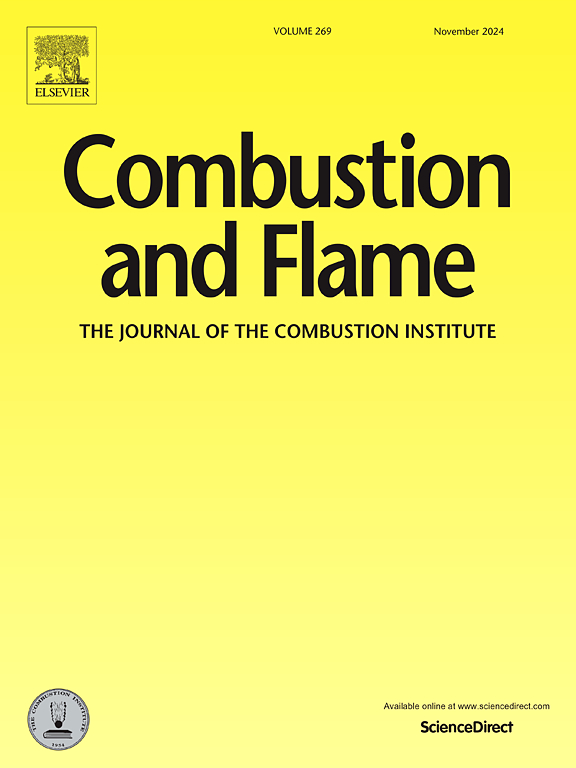Insights into the scalar structures in turbulent diffusion flames with progressive H2 addition using 1D spontaneous Raman scattering and simultaneous PIV-OH PLIF
IF 5.8
2区 工程技术
Q2 ENERGY & FUELS
引用次数: 0
Abstract
This paper examined the effect of H2 enrichment in a primary fuel (CH4) on turbulent flame features using 1D spontaneous Raman scattering (SRS) and simultaneous particle Image Velocimetry (PIV), OH-Planar Laser Induced Fluorescence (PLIF) measurements. The experiments are conducted in a canonical non-premixed bluff body burner operating under typical central fuel jet-dominated flow mode. Downstream of the bluff body, the flow exhibits complex patterns, and it can be globally categorized into three successive zones: recirculation, neck, and jet-like zones. The flame undergoes local extinction in the neck zone, where the local flow-induced hydrodynamic strain rate (κhyd) is much higher than the flame extinction strain rate (κext). It is well known that H2 enrichment increases κext and thus modifies the probability of localized flame extinctions in the neck zone. Additionally, recent studies have shown the significance of preferential diffusion effects of H2 in H2 + CH4 bluff body stabilized premixed and turbulent jet diffusion flames. Although 1D SRS measurements in canonical jet and bluff body stabilized non-premixed flames were studied extensively, to the best of our knowledge, differential diffusion has not been reported earlier in the non-premixed bluff body burner fueled with progressive H2 addition. To better understand this phenomenon, five H2 enrichment levels are considered: 0 %, 10 %, 30 %, 50 % and 80 % (in vol.). The simultaneous PIV and OH-PLIF measurements revealed the presence of local extinctions in the cases of H2 enrichment ≤ 30 %, while local extinctions are not witnessed for H2 = 50, 80 %. The conditional PDFs of the temperature in mixture fraction space obtained from the 1D SRS further confirmed this observation. Furthermore, the local instantaneous hydrogen/methane mass fraction ratio has been estimated to evaluate the differential diffusion effects. The results showed the dominance of the differential diffusion in the burner's near field, while the strong turbulence mixing effect weakens the differential diffusion in the far field.
利用一维自发拉曼散射和同步PIV-OH PLIF研究H2加成湍流扩散火焰中的标量结构
本文利用一维自发拉曼散射(SRS)和同步粒子图像测速(PIV)、oh -平面激光诱导荧光(PLIF)测量技术研究了初级燃料(CH4)中H2富集对湍流火焰特征的影响。实验在典型的非预混钝体燃烧器上进行,工作在典型的中心燃油射流主导流模式下。在钝体的下游,流动表现出复杂的模式,总体上可以分为三个连续的区域:再循环区、颈状区和射流区。火焰在颈区发生局部熄灭,其局部流致水动力应变率(κhyd)远高于火焰熄灭应变率(κext)。众所周知,H2富集增加了κext,从而改变了颈部区域局部火焰熄灭的可能性。此外,最近的研究表明H2在H2 + CH4钝体稳定预混流射流扩散火焰中的优先扩散效应具有重要意义。尽管在典型射流和钝体稳定的非预混火焰中进行了广泛的一维SRS测量,但据我们所知,在以加氢燃料为燃料的非预混钝体燃烧器中,微分扩散尚未有早期报道。为了更好地理解这一现象,我们考虑了5种H2富集水平:0%、10%、30%、50%和80%(以体积计)。PIV和OH-PLIF同时测量结果显示,当H2浓度≤30%时,存在局部灭灭现象,而当H2浓度= 50%和80%时,没有发生局部灭灭现象。一维SRS得到的混合分数空间温度的条件pdf进一步证实了这一观察结果。此外,估计了局部瞬时氢/甲烷质量分数比,以评估微分扩散效应。结果表明,燃烧器近场的微分扩散占主导地位,而强湍流混合效应减弱了远场的微分扩散。
本文章由计算机程序翻译,如有差异,请以英文原文为准。
求助全文
约1分钟内获得全文
求助全文
来源期刊

Combustion and Flame
工程技术-工程:化工
CiteScore
9.50
自引率
20.50%
发文量
631
审稿时长
3.8 months
期刊介绍:
The mission of the journal is to publish high quality work from experimental, theoretical, and computational investigations on the fundamentals of combustion phenomena and closely allied matters. While submissions in all pertinent areas are welcomed, past and recent focus of the journal has been on:
Development and validation of reaction kinetics, reduction of reaction mechanisms and modeling of combustion systems, including:
Conventional, alternative and surrogate fuels;
Pollutants;
Particulate and aerosol formation and abatement;
Heterogeneous processes.
Experimental, theoretical, and computational studies of laminar and turbulent combustion phenomena, including:
Premixed and non-premixed flames;
Ignition and extinction phenomena;
Flame propagation;
Flame structure;
Instabilities and swirl;
Flame spread;
Multi-phase reactants.
Advances in diagnostic and computational methods in combustion, including:
Measurement and simulation of scalar and vector properties;
Novel techniques;
State-of-the art applications.
Fundamental investigations of combustion technologies and systems, including:
Internal combustion engines;
Gas turbines;
Small- and large-scale stationary combustion and power generation;
Catalytic combustion;
Combustion synthesis;
Combustion under extreme conditions;
New concepts.
 求助内容:
求助内容: 应助结果提醒方式:
应助结果提醒方式:


